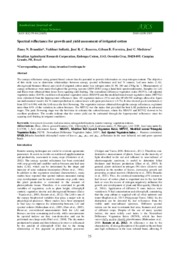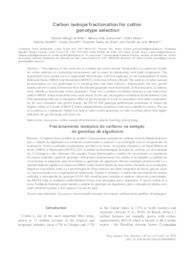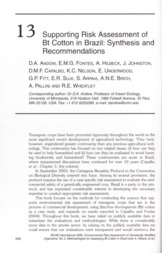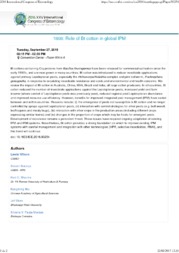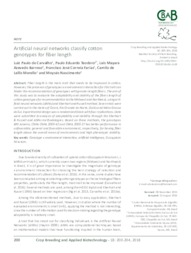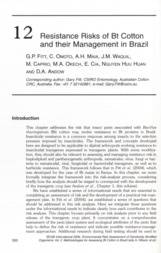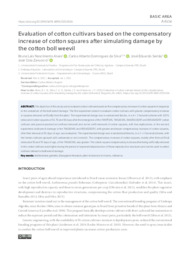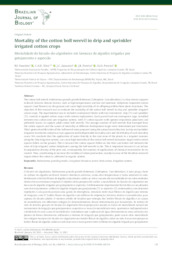Search Publications
Filter by:
| Author(s): BRANDAO, Z. N.; SOFIATTI, V.; BEZERRA, J. R. C.; FERREIRA, G. B.; MEDEIROS, J. C. The canopy reflectance using ground-based sensors has the potential to provide information on crop nitrogen content. The objective of this study was to determine relationships between canopy spectral... ... |
| Author(s): BRITO, G. G. de; SUASSUNA, N. D.; DIOLA, V.; SOFIATTI, V.; DUCATTI, C.; SILVA, E. T. da; MORELLO, C. de L. The objective of this work was to evaluate the carbon isotope fractionation as a phenomic facility for cotton selection in contrasting environments and to assess its relationship with yield components... ... |
| Author(s): ANDOW, D. A.; FONTES, E. M. G.; HILBECK, A.; JOHNSTON, J.; CAPALBO, D. M. F.; NELSON, K. C.; UNDERWOOD, E.; FITT, G. P.; SUJII, E. R.; ARPAIA, S.; BIRCH, A. N. E.; PALLINI, A.; WHEATLEY, R. E. Capítulo 13: Cotton in Brazil and the Lepidopteran pests. Problem formulation and options assessment. Transgene expression and locus structure. Non-target and biodiversity effects. Gene flow and conse... ... |
| Author(s): WILSON, L.; NARANJO, S.; SHARMA, H. C.; WU, K.; GORE, J.; MORAES, S. V. de P.
|
| Author(s): SHARMAN, M.; LAPBANJOB, S.; SEBUNRUANG, P.; BELOT, J. -L.; GALBIERI, R.; GIBAND, M.; SUASSUNA, N. D. Partial virus genome sequence with high nucleotide identity to Cotton leafroll dwarf virus (CLRDV) was identified from two cotton (Gossypium hirsutum) samples from Thailand displaying typical cotton l... ... |
| Author(s): CARVALHO, L. P. de; TEODORO, P. E.; BARROSO, L. M. A.; FARIAS, F. J. C.; MORELLO, C. de L.; NASCIMENTO, M. Fiber length is the main trait that needs to be improved in cotton. However, the presence of genotypes x environments interaction for this trait can hinder the recommendation of genotypes with greater... ... |
| Author(s): FITT, G. P.; OMOTO, C.; MAIA, A. de H. N.; WAQUIL, J. M.; CAPRIO, M.; OKECH, M. A.; CIA, E.; NGUYEN, H. H.; ANDOW, D. A.
|
| Author(s): ALVES, B. L. N.; SILVA, C. A. D. da; SERRÃO, J. E.; ZANUNCIO, J. C. The objective of this study was to evaluate cotton cultivars based on the compensatory increase of cotton squares in response to the simulation of the boll weevil damage. The first experiment aimed to... ... |
| Author(s): FAUSTINO, R. F.; SILVA, C. A. D. da; ZANÚNCIO, J. C.; PEREIRA, J. R.; PEREIRA, A. I. A. The cotton boll weevil, Anthonomus grandis grandis Boheman (Coleoptera: Curculionidae), is a key cotton crop pest in Brazil. Adverse climatic factors, such as high temperatures and low soil moisture,... ... |
| Author(s): PEIXOTO, M. A.; EVANGELISTA, J. S. P. C.; COELHO, I. F.; CARVALHO, L. P. de; FARIAS, F. J. C.; TEODORO, P. E.; BHERING, L. L. ABSTRACT - In cotton crops, the cotton seed yield significantly contributes with the success of any cultivar. However, other traits are considered when an ideotype is pointed out in the selection, suc... ... |
Observation
Some of Embrapa's publications are published as ePub files. To read them, use or download one of the following free software options to your computer or mobile device. Android: Google Play Books; IOS: iBooks; Windows and Linux: Calibre.
Access other publications
Access the Agricultural Research Database (BDPA) to consult Embrapa's full library collection and records.
Visit Embrapa Bookstore to purchase books and other publications sold by Embrapa.

